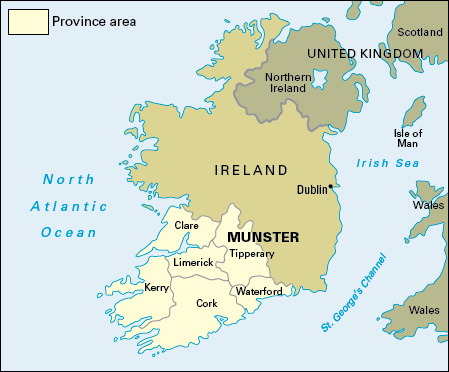Limerick, County, is a county along the estuary (coastal river mouth) of the River Shannon in the southwest of Ireland. It is one of the counties in the province of Munster. Much of the county consists of green pastures and meadows.

About half of County Limerick’s population live in and around the city of Limerick. The majority of the county’s people are Roman Catholic. Most of the rest are members of the Church of Ireland or claim no religious affiliation.
The Newtown Perry district of Limerick city has Georgian houses and wide streets that were laid out in the 1700’s. It is now the city’s main business district. The village of Adare has remains of a medieval castle, churches, and monasteries. The earls of Dunraven later remodeled the village and built Adare Manor, which is now a hotel. County Limerick has more castles dating from the Middle Ages (about the 400’s through the 1400’s) than any other Irish county.
Economy.
Agriculture contributes significantly to County Limerick’s economy. Most of the land is suitable only for grazing cattle. The county is known for its dairy farming, which is the leading agricultural activity. Some farmers raise beef cattle or poultry.

The construction and manufacturing sectors are also important. Most manufacturing is in the city of Limerick, which is one of the main industrial centers in Ireland. Much industrial employment is in engineering, particularly such light industry as electronic engineering and the production of household appliances, machinery, and medical and optical supplies. The traditional basis of County Limerick’s manufacturing was food processing, and this industry remains important. It includes the production of bacon and other meat products, dairy processing, and milling. Limerick lace, a type of embroidery, was a major product of Limerick city in the mid-1800’s. Today, small-scale lacemakers and hobbyists continue the tradition of making Limerick lace.
Service industries are the leading source of employment in County Limerick. The city of Limerick is the major service center for the midwestern region of Ireland. Leading services include education, finance, food services and hotels, health care and social work, professional services, public administration, retail and wholesale trade, and transportation. The University of Limerick is just outside Limerick city. The county also has colleges for art, business, education, music, and technology.
The city of Limerick is a major transportation center. It is at the lowest point downstream where bridges can be conveniently built across the River Shannon. County Limerick receives most of the shipping on the west coast of Ireland. Its ports are the harbor of Limerick city and the deepwater ports of Foynes and Aughinish on the Shannon estuary. Railroads cross the county.
Land.
The Shannon estuary and river form much of the northern boundary of County Limerick. County Tipperary is to the east, County Cork to the south, and County Kerry to the west. County Limerick is roughly rectangular in shape, measuring about 50 miles (80 kilometers) from east to west and 25 miles (40 kilometers) from north to south.
Most of County Limerick consists of rolling limestone lowland. Hills of volcanic rock and sandstone rise from the lowland. The Rivers Deel, Maigue, and Mulkear drain the lowland northward to the Shannon estuary.
The uplands (hills and mountains) of County Limerick lie along its edges and are shared with other counties. They consist of sandstones, shales, and slates. The highest are the Galty Mountains, which rise to 2,600 feet (790 meters) in the southeast. This ridge continues westward as the Ballyhoura Mountains. The Slievefelim Mountains lie in the northeast. In the west, the land rises to a low plateau toward the Kerry border, with the Mullaghareirk Mountains to the south. Parts of these uplands have been planted with forest.
History.
Evidence from the Lough Gur area shows that people were living in what is now County Limerick more than 5,000 years ago. In Gaelic times, the region was in the kingdoms of Thomond and Desmond. One of the treasures of Ireland’s Celtic monastic heritage, the Ardagh Chalice, was found in western County Limerick. After the Anglo-Norman invasion of the 1100’s, families such as the de Burgos and Fitzgeralds gained control of lands in Limerick. After periods of war in the 1500’s and 1600’s, the British government granted lands to British settlers, but these plantations (settlements of colonists) had limited success.

Limerick city was founded by the Vikings around A.D. 900. The Anglo-Normans developed it from the late 1100’s. The early settlement was on an island in the River Shannon that became known as Englishtown. On it are St. Mary’s Cathedral and King John’s Castle, which both date from the Middle Ages. The city is famous in Irish history as the scene of several events of the Williamite War during the late 1600’s. The Treaty of Limerick, which ended the war, was signed in the city in 1691.
See also Ireland, History of.
